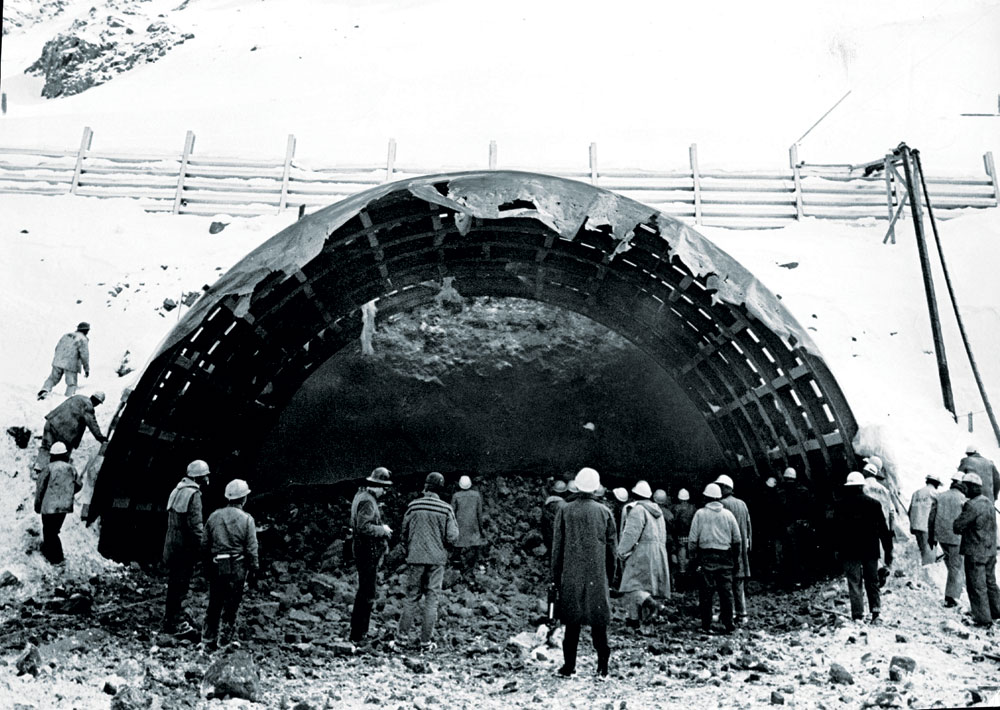 Last weekend we cruised through one of our favorite stretches of I-70. All three kids shouted “tunnel!” as we approached the entrance, and the whoops and hollers continued all the way through. Yeah, you know the one. The Eisenhower-Johnson Memorial Tunnel system, or EJMT.
Last weekend we cruised through one of our favorite stretches of I-70. All three kids shouted “tunnel!” as we approached the entrance, and the whoops and hollers continued all the way through. Yeah, you know the one. The Eisenhower-Johnson Memorial Tunnel system, or EJMT.
What’s the story behind these tunnels? Initially opened in 1973, they’re the highest in the world, whisking 11 million autos per year from one side of the Continental Divide to the other. They’re one of Colorado’s most iconic and impactful arteries and have a remarkable history.
Before digging into the tunnels, first a quiz: Who are they named after?
Presidents Eisenhower and Johnson? Actually, the Johnson Tunnel is named after Edwin “Big Ed” Johnson, our former senator and governor, who was EJMT’s most vociferous advocate.
Big Ed astutely argued that completion of the tunnels would catalyze the biggest boom in mountain towns since the Colorado gold rush. And boy did they. Suddenly meager ski burgs like Breckenridge were connected not just to Denver, but to the east. They flourished rather than decaying away like other former mining towns.

On a snowy day in 1973, a crew looked at the pile of rocks after the first blasts on the west side of the Continental Divide. At the time, the project was the most ambitious federal-aid highway program in the nation. It was later named the Eisenhower Tunnel. Photo by John G. White/Denver Post
Building the tunnels did have downsides. Seven workers died while tunneling the Continental Divide, largely because they had to navigate a horde of geologic problems, ranging from groundwater-soaked schist to fractured and faulted granite.
The tunnels marked a national turning point in the fight for workplace equality. CDOT (then called the Division of Highways) accidentally hired engineer Janet Bonnema to work on the tunnel, after misspelling her name and thinking she was a guy named “Jamet.” Despite being told “a tunnel was no place for a woman,” Janet wanted to work the tunnel project. After a year and a half of being relegated to outside-of-the-tunnel work, she was fed up and ready to collect her instrument readings in the tunnel, just like her male counterparts did. After she sued for equal treatment, the courts forced a change to state and national transportation workplace policies. Janet began work in the tunnels on Nov. 9, 1972. On the first day, 66 men walked off the job in protest. But she did her job well, and paved the way for other women to pursue careers in construction, mining and transportation.
Even today, the tunnels are not without risk. Some are mitigated by quickly clearing accidents or stalled cars, by diverting trucks carrying hazardous materials over Loveland Pass, and by using special lighting to help alleviate the exit-blinding that happens when motorists leave the tunnel. But others are less avoidable. Like when you’re stuck in tunnel traffic and your kid suddenly says “Papa, I have to go to the bathroom really, really bad.” And that’s a bummer about the EJMT; there’s no shoulder nor are there bathrooms there anymore because they were shut down after 9/11.
Compared to the roadways of the past, the tunnels are phenomenally safe. Not a single death in 40 years of operation. In part this is because the EJMT and its staff are evolving to keep pace with increased traffic demand and vehicular risks. For example, the tunnels have their own war room, where staff monitor toxic gases from car exhaust, like carbon monoxide. Your car emits more of these gases at 11,000 feet than down in the Front Range, and they can accumulate quickly in a tunnel. Therefore tunnel air is circulated through ducts stashed above the road we drive on. Those ducts are nearly as tall and wide as the road itself.
War room workers also monitor and mitigate the hundreds of breakdowns and accidents that occur each year in the tunnels. Although there are only a few fires per year in the tunnels, they’re also a major concern. For comparison, California’s 2007 Newhall Pass tunnel fire was triggered by a traffic accident and left 3 dead, 10 injured, 30 vehicles damaged, and the tunnel closed for 5 weeks. The good news is that an overhead fire suppression system is in the works to prevent such a disaster in the EJMT.
So what’s next for the tunnels? No doubt they’ll continue to evolve. I hope their future also includes a pit stop or a fun coat of paint.
James Hagadorn, Ph.D., is a scientist at the Denver Museum of Nature & Science.Suggestions and comments welcome at jwhagadorn@dmns.org.




I would like to buy my granddaughter a book on history of the Eisenhower tunnel. Please direct me.